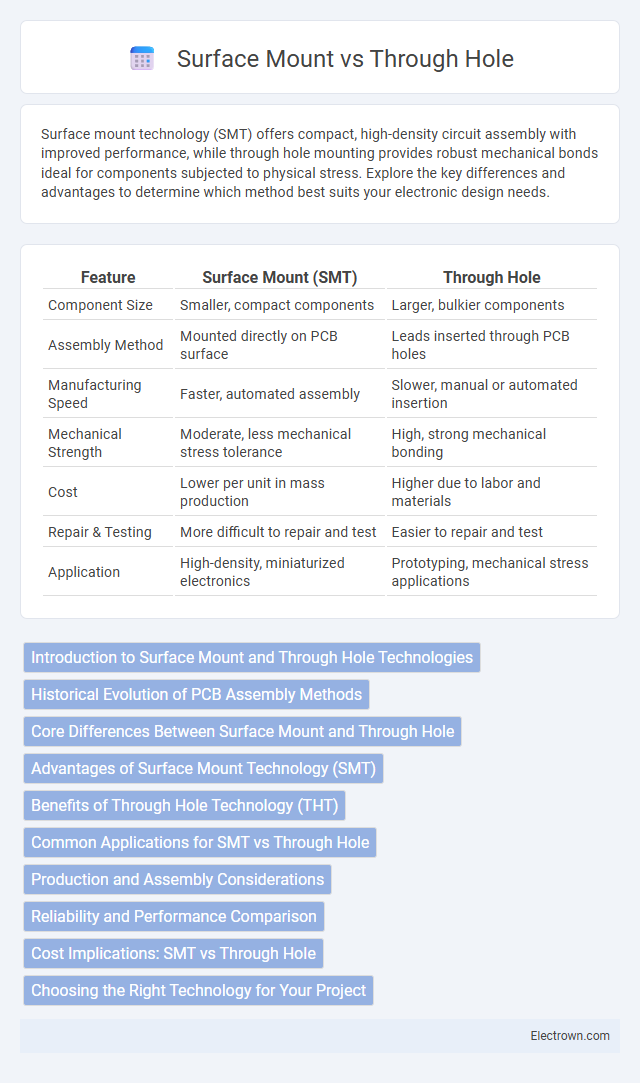Surface mount technology (SMT) offers compact, high-density circuit assembly with improved performance, while through hole mounting provides robust mechanical bonds ideal for components subjected to physical stress. Explore the key differences and advantages to determine which method best suits your electronic design needs.
Table of Comparison
| Feature | Surface Mount (SMT) | Through Hole |
|---|---|---|
| Component Size | Smaller, compact components | Larger, bulkier components |
| Assembly Method | Mounted directly on PCB surface | Leads inserted through PCB holes |
| Manufacturing Speed | Faster, automated assembly | Slower, manual or automated insertion |
| Mechanical Strength | Moderate, less mechanical stress tolerance | High, strong mechanical bonding |
| Cost | Lower per unit in mass production | Higher due to labor and materials |
| Repair & Testing | More difficult to repair and test | Easier to repair and test |
| Application | High-density, miniaturized electronics | Prototyping, mechanical stress applications |
Introduction to Surface Mount and Through Hole Technologies
Surface mount technology (SMT) involves placing electronic components directly onto the surface of printed circuit boards (PCBs), allowing for smaller, more compact designs with higher component density compared to traditional methods. Through hole technology (THT), by contrast, uses components with leads inserted through drilled holes in the PCB and soldered on the opposite side, providing strong mechanical bonds ideal for components subjected to mechanical stress. SMT is widely used in modern electronics manufacturing due to automation efficiency and miniaturization, while THT remains preferred for applications requiring enhanced durability and reliability.
Historical Evolution of PCB Assembly Methods
Surface mount technology (SMT) revolutionized PCB assembly by enabling smaller, faster, and more efficient circuit designs compared to traditional through-hole methods that dominated since the 1950s. Through-hole components, preferred for their mechanical strength and ease of manual assembly, gradually gave way to SMT in the 1980s due to increased demand for miniaturization and automated production. Your understanding of this historical evolution highlights the shift from bulky, slower assemblies to high-density, high-speed electronic manufacturing processes.
Core Differences Between Surface Mount and Through Hole
Surface mount technology (SMT) involves placing components directly onto the surface of printed circuit boards (PCBs), enabling more compact and lightweight designs, while through hole technology uses leads inserted into drilled holes for stronger mechanical bonds. SMT supports higher component density and automated assembly, ideal for complex and miniaturized electronics, whereas through hole excels in durability and is preferred for components subject to mechanical stress. Your choice depends on the application requirements, including space constraints, manufacturing volume, and durability needs.
Advantages of Surface Mount Technology (SMT)
Surface Mount Technology (SMT) offers significant advantages including higher component density, enabling more compact and lightweight circuit designs. SMT components allow for automated assembly processes, which increase production speed and reduce labor costs. Enhanced electrical performance and reliability are achieved due to shorter lead lengths and improved signal integrity.
Benefits of Through Hole Technology (THT)
Through Hole Technology (THT) offers superior mechanical strength and durability ideal for components subject to physical stress or heavy connectors, ensuring reliable long-term connections. THT provides better heat dissipation and improved electrical performance in high-power applications, enhancing circuit stability. Your electronics will benefit from easier prototyping and manual assembly with THT, especially in low-volume production or repair scenarios.
Common Applications for SMT vs Through Hole
Surface Mount Technology (SMT) is predominantly used in high-density electronic circuits such as smartphones, laptops, and other compact consumer electronics due to its ability to support smaller components and automated assembly processes. Through Hole technology finds common applications in devices requiring high mechanical strength and reliability, including automotive electronics, power supplies, and military equipment, where components experience higher levels of stress and heat. SMT is favored in mass production environments for its efficiency and speed, whereas Through Hole remains preferred for prototyping and circuits needing robust connections.
Production and Assembly Considerations
Surface mount technology (SMT) enables faster production and higher component density compared to through-hole mounting, making it ideal for automated assembly lines. Through-hole components provide stronger mechanical bonds, preferred in applications requiring enhanced durability and heat dissipation. Your choice between SMT and through-hole affects assembly time, manufacturing cost, and reliability based on production volume and product design requirements.
Reliability and Performance Comparison
Surface mount technology (SMT) offers superior performance through smaller package sizes, higher component density, and improved high-frequency characteristics compared to through hole technology. Reliability in SMT is enhanced by better thermal cycling endurance and reduced mechanical stress due to lower lead mass, whereas through hole components can provide stronger mechanical bonds ideal for high-stress environments. Performance-wise, SMT facilitates faster automatic assembly and higher circuit complexity, while through hole parts excel in applications requiring robust physical connections.
Cost Implications: SMT vs Through Hole
Surface Mount Technology (SMT) typically offers lower production costs compared to Through Hole technology due to automated assembly processes and higher component density, reducing material usage and board size. Through Hole components often increase manufacturing expenses because of more complex drilling, insertion, and soldering steps, leading to longer assembly times and higher labor costs. SMT's efficiency and scalability make it more cost-effective for high-volume production runs, whereas Through Hole is generally reserved for prototypes, low-volume applications, or components requiring mechanical strength.
Choosing the Right Technology for Your Project
Choosing between Surface Mount Technology (SMT) and Through Hole Technology (THT) depends on your project's requirements for size, durability, and production volume. SMT offers compact, high-density circuit designs ideal for modern electronics, while THT provides stronger mechanical bonds suited for components exposed to physical stress. Evaluating factors like assembly cost, component availability, and repairability will help determine the best fit for your specific application.
Surface Mount vs Through Hole Infographic

 electrown.com
electrown.com